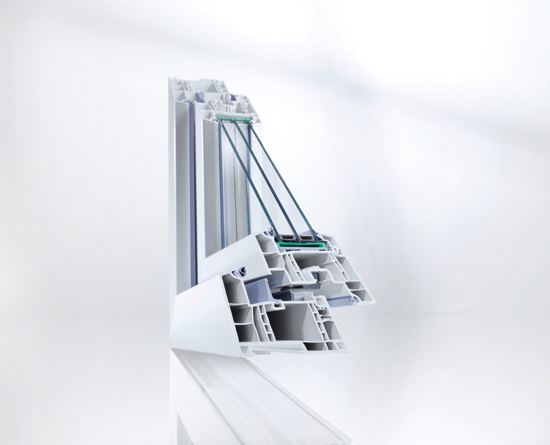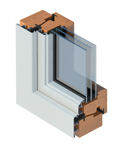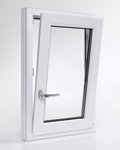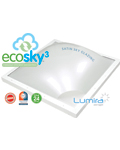Fenestration Solutions for Efficiency and Performance
Thermal and Structural Specs
With today's variety of glazing options, architects are specifying windows and curtain walls with a range of high-performance coatings, fills, and unit designs. “We see more projects employing specialized glass coatings, films, gas-filled and triple-glazed units,” says Menck's Wall. “Thermal bridging is carefully considered in the construction of the window assemblies, such as extruded aluminum clad on wood windows where thermal bridging can be mitigated by not adhering the cladding to the face of the window but instead suspending the aluminum to minimize thermal movement.”
For many owners seeking to improve thermal performance for existing building stock, it may not be feasible to renovate the entire envelope system. Some retrofit methods, such as adding new shading, glazing treatments, or films, may not be worth the expense and effort in certain cases, says William R. Brody, vice president with construction management firm B.R. Fries & Associates. “Instead, we see a large number of window replacement projects where the primary goal for the institutional or commercial owner is energy efficiency,” he says, pointing to recent examples by major universities and hospitals. “An energy analysis will show that fenestration is the leading source of heat loss, though it may be a close second to the roof in some cases.”
The energy-saving techniques built into replacement fenestration also benefit project teams facing aggressive state codes such as Title 24, which are “all about reducing solar heat gain by using better glazing materials,” says Wasco's Reeves. “Both Title 24 and IECC look to the National Fenestration Rating Council, or NFRC, as the guideline, and they favor total system energy efficiency that includes the framing and glazing, not merely the center-of-glazing efficiency,” he adds. For curtain wall and structural skylights, the framing is often aluminum, which is highly conductive, he adds.
Even though the skylight may be 98 percent glass and only 2 percent metal, the aluminum or steel will significantly affect its thermal performance. New framing alternatives to aluminum or wood include inner vinyl frames, which provide thermal breaks, and fiberglass pultrusions, also known as pultruded fiberglass. (A number of frame materials, including hybrid compositions, are available for punched window openings.)
While vinyl is now an option for skylight frames and skylights, some of the products are not suited to larger openings such as for structural skylights, which need hefty aluminum or other metal framing to support their weight across larger desired roof spans. “As building designs require larger and larger fenestration systems, traditional materials such as exposed aluminum and steel are typical for commercial applications,” says SmithMaran's Walker. “The key is to maintain structural integrity on the perimeter and at all corners and to provide a continuous thermal break, working with the manufacturers to identify any natural weak points in terms of structure or thermal bridging.” As an example, for continuous openings such as clerestory or ribbon windows, the lintel can become the bridge for thermal movement and moisture migration.
The NFRC independently tests, certifies, and labels the fenestration products for U-factor, SHGC, and visible transmittance (VT), which are all mandated for minimum performance. Additional ratings can be added by testing for air leakage rates—typically between 0.1 and 0.3 cubic feet per minute per square foot (cfm/ft2), where lower is better. (According to one manufacturer, the passing rate of 0.3 cfm/ft2 can be an uncomfortably drafty assembly, even as it meets the minimum standard.) For condensation resistance—given as a number between 1 and 100 where higher indicates better ability to resist condensation—architects must consider the expected conditions of each project's regional climate zone and local microclimates such as urban and coastal sites. Other factors not tested by NFRC but rated by others and essential to many project specifications include:
• Water infiltration. How much water and pressure a window system can resist to keep the water from leaking through.
• Structural performance. These ratings test for the maximum air pressure (wind load) a window can bear prior to a failure. Local codes generally establish these minimums.
• Acoustical isolation. Testing the amount of sound transmission through a window yields a rating for sound transmission class, or STC, where the higher the number, the better it is at blocking noise. (Other ratings such as OITC may be used.)
• Security capacity. These ratings measure the ability of a window to resist different types of forces, such as those caused by windborne projectiles, fire and heat, ballistics, and attempted forced entry.
For the latter category, a number of new design features mark emergency exit doors and other exterior door systems. For example, new flush panic devices for fire exits offer a break from the typical look of the bulky, obtrusive panic bars on many exit door products, while opening up egress clearances and protecting building occupants against hitting or getting caught on the bars while exiting. The smallest projection in the industry is about 1/8 inch with the door in the open position. This makes it virtually flush with the door face. When closed, it pops out to about 5/8 inches to meet all fire codes and ADA guidelines.
“The glass may be ballistically rated, but the frame should be also,” says SmithMaran's Walker, who has specified security fenestration for K-12 school projects and recommends using the federal government's ballistics rating guide as a starting point. “This requires a steel plate or similar inserted into the frame, which is then tested and rated, and only a handful of manufacturers can provide these assemblies.”
U-Factors, Heat Gain, and Light
When it comes to energy performance and sustainability, however, the IECC and other codes focus on prescriptive and performance-based paths for keeping U-factors and SHGC as low as possible while keeping VT—also given in some codes as VLT, for visible light transmittance—as high as possible. The standard NFRC 100-04 and tables given in the IECC provide allowable maximums for U-value, and the standard NFRC 200-04 and tables offer similar guidance for SHGC limits for building fenestration.
The paths for compliance with IECC include alternates to the prescriptive requirements, and many architects prefer the opportunity to design the building without prescriptive performance requirements or specific fenestration limits, for example. Two ways that IECC allow this flexibility—performance-based, whole-building design as well as the total UA alternate method—provide the design team latitude to make decisions about energy efficiency tradeoffs. The performance-based alternate path is the most flexible, however, because the UA method only allows those tradeoffs to occur within the design of the building envelope. Neither of the paths, however, affords unlimited tradeoffs—those are capped—and neither allows the architect to compensate for a less efficient envelope with a more efficient HVAC system. (Long term, many sustainability experts argue, this seems like a sensible limitation.)
Using the residential IECC 2012 edition as an example, SHGC is capped in the Southern climate zones at 0.50, but there is no U-factor cap in these warmer areas. Yet there is a U-factor cap for cold northern regions, given as climate zones 6, 7 and 8. In between, in areas such as Missouri and Utah, project designs may not exceed the U-factor of 0.48. If the design team is using an alternative path for compliance with IECC, limits on U-factor and SHGC may be given for skylights, windows and exterior glazed doors. Bounded by prescribed caps, architects can make any tradeoffs in efficiency that they feel benefit the project's requirements for budget, schedule, aesthetics, and performance.
For the special case of exterior doors with glazing, if the framed assemblies total less than half glass in measured area, they are considered opaque doors; more than half glass, they are glass doors that are subject to specific limits similar to windows and skylights. All doors are considered fenestration in the IECC's view, however, and even opaque doors must be factored into building energy calculations. As an example, the U-factor of an opaque door in the IECC's 2012 version may not exceed 0.35, says AAMA's Ruth, with an exception made for a single opaque door of up to 24 feet in total area, which may be exempted.
The benefits of meeting the requirements of the IECC go beyond mere code compliance. They also include a fundamental technique for reducing facility operating costs and carbon footprint.
A recent analysis reported by Menck shows the bottom-line results of using better fenestration technology. Under assumed conditions, a single-pane window annually requires 1.65 gallons of heating oil per square foot to maintain interior temperatures, where a double-pane uncoated window will reduce that need for heating oil by 49 percent to 0.81 gallons per square foot of window area. To reduce that by another 42 percent, specify a double-pane insulated glass and only 0.34 gallons of heating oil are needed annually, according to Menck's analysis. A triple-pane insulated glass further reduces the energy need by 56 percent, to 0.19 gallons of oil per year to maintain heated interiors.2
Window Wall Interface
Critical to the energy-efficient design of a building envelope with fenestration is the detailing of the window-wall interface, an area of significant research and development in recent years. Far from simple joints, these interfaces are locations of multiple system details and a high degree of coordination between various trades, says B.R. Fries' Brody. Leading energy-efficiency advocates and enclosure consultants like Wagdy Anis, FAIA, a principal with Wiss Janney Elstner, Inc., have described, for example, how air-barrier continuity must be rigorously maintained at window openings. The architect's documentation must protect against improper design and installation techniques can lead to pathways for air leakage that drastically reduce building efficiency, say the experts.
One benefit of European tilt-turn technology, says Menck's Wall, is that the product types have been specifically designed to enhance their effective installation at the window-wall interface. These and other window products are designed with high-performance fastening, flashing, and insulation continuously and securely assembled around the window-wall interface.
“It's important for us as the manufacturer to involve the architect and builder early in the process and create the details for the window to fit properly and securely into the wall,” says Wall. “We encourage the architect to submit their wall section CAD files,” he adds, so they can drop a window design into the section and show how all accessories work together. These should include uninterrupted air and moisture barriers indicated and with continuous insulation to address sound and efficiency needs as required by the design intent.
Many of the European window and door products, such as the tilt-turn systems used increasingly in the United States, are made with sturdy frames of metal or unplasticized polyvinyl chloride (uPVC), a rigid and durable material that contains no pthalates or bisphenol A (BPA), unlike its cousin PVC. The growth of interest in uPVC material reflects its effectiveness in various building uses. As window and door framing, uPVC does not deflect or flex much as compared to other, and it resists fire, weather, oxidation, sunlight and ultraviolet rays, mold, and most common chemicals. It is also recyclable, according to manufacturer sources, and provides a good thermal break as compared to metals.
The material uPVC is often marketed as “rigid PVC” or unplasticized poly, and it is also simply called “vinyl” in the context of vinyl siding and other commonly used materials in the United States. It is also used extensively as plumbing and drainage piping. For architectural applications, uPVC provides an effective substitute for painted wood, and uPVC can be made in a range of integral colors and patterns, including a wood-look finish. The material also benefits window frame sections by helping reduce thermal bridging and overall sound transmission as compared to metals.

Photo courtesy of REHAU North America
The use of new uPVC tilt-turn windows and doors can help improve sound-transmission class (STC) performance for better acoustical isolation indoors.
Notice

www.dowcorning.com/construction

www.menckwindows.com

www.na.rehau.com/4500

www.wascoskylights.com/ecosky3









